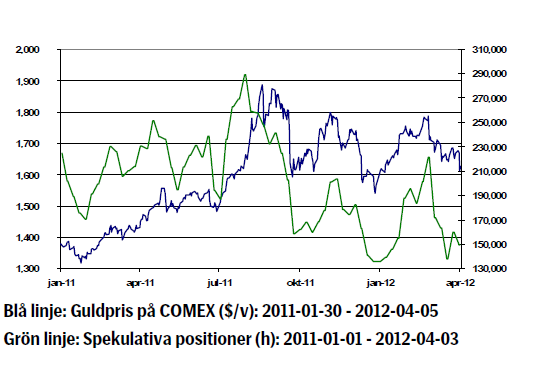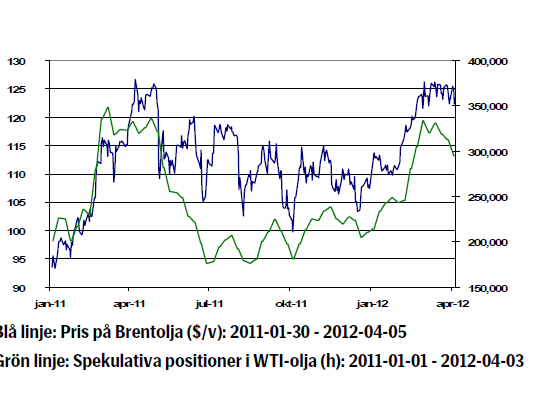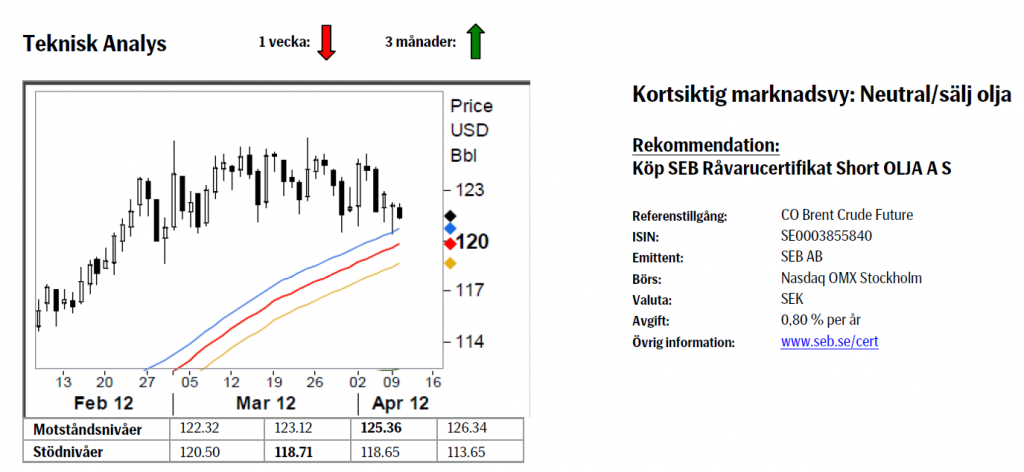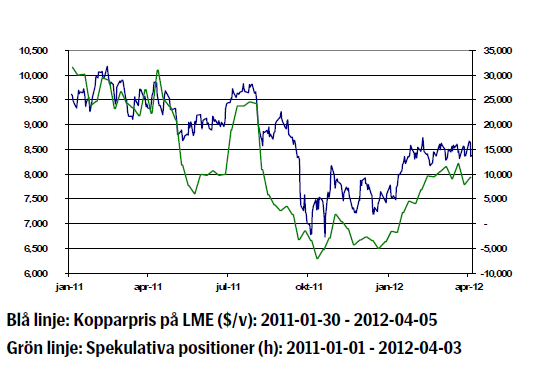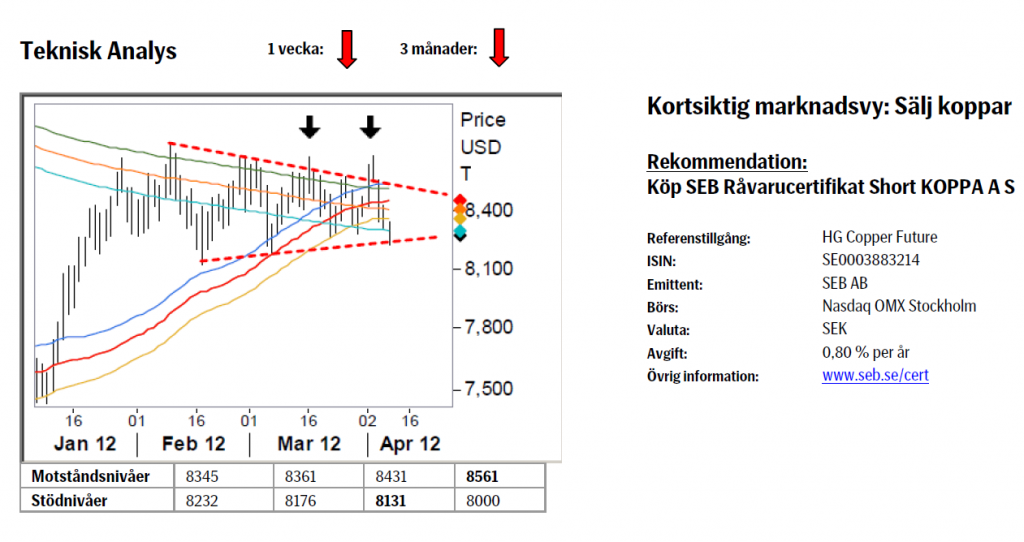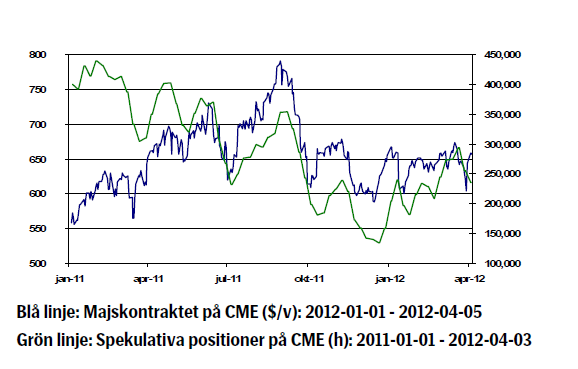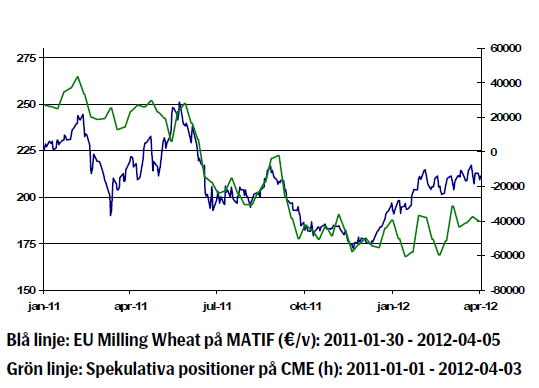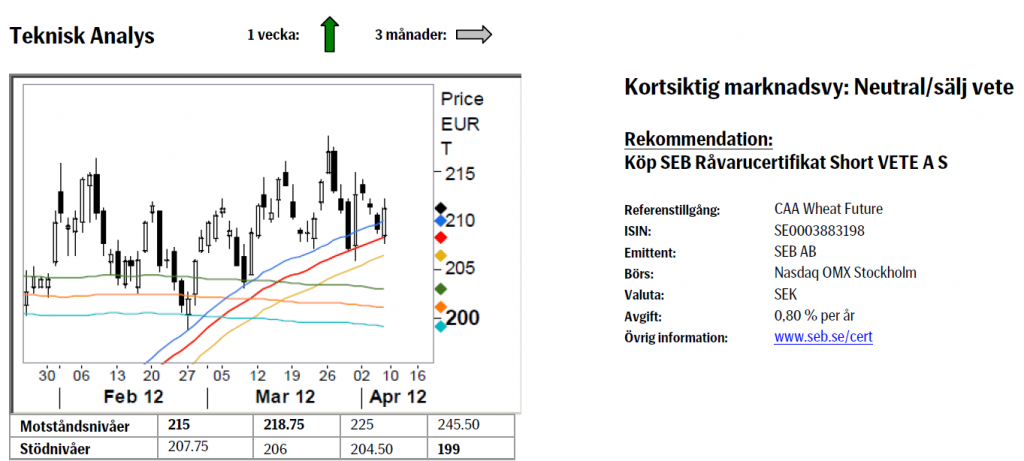Analys
SEB – Råvarukommentarer vecka 15 2012
Sammanfattning: Föregående vecka
 Brett råvaruindex: -0,10 %
Brett råvaruindex: -0,10 %
UBS Bloomberg CMCI TR Index- Energi: +0,28 %
UBS Bloomberg CMCI Energy TR Index - Ädelmetaller: -2,46 %
UBS Bloomberg CMCI Precious Metals TR Index - Industrimetaller: -0,22 %
UBS Bloomberg CMCI Industrial Metals TR Index - Jordbruk: -0,06 %
UBS Bloomberg CMCI Agriculture TR Index
Kortsiktig marknadsvy:
- Guld: Neutral/köp
- Olja: Neutral/sälj
- Koppar: Sälj
- Majs: Sälj
- Vete: Neutral/sälj
Guld
- Guldpriset föll 1,5 procent förra veckan och nådde på onsdagen tillfälligt 1614 dollar, den lägsta nivån på 12 veckor. Nedtonade förväntningar om ytterligare stimulanser från Federal Reserve fick guldet att falla och dollarn steg mot de flesta övriga valutor.
- Ekonomin utvecklas svagt i Europa, vilket avspeglas i ett svagt inköpschefsindex. Detta låg för mars månad under den nivå som indikerar en industriell expansion.
- Vidare har oron för Spanien tagit fart igen. Landet har svårt att nå tillräckliga besparingar för att få bukt med ett allt för stort budgetunderkott. Detta samtidigt som Tyskland ser en stigande inflation på grund av de största löneökningarna på 20 år.
- I Indien fortsätter juvelerarnas strejk, vilken nu har pågått i två veckor. Strejken är en protest mot en nytillkommen ökning på skatten av obearbetat importerat guld. Kortsiktigt bör dock inte guldpriset påverkas nämnvärt av strejken.
- Fredagens amerikanska arbetsmarknadssiffror kom ut sämre än förväntat och öppnar upp för nya spekulationer avseende ett nytt paket av kvantitativa lättnader i USA. Detta bör kunna ge stöd åt guldet den närmaste tiden.
- Teknisk Analys: Marknaden har utvecklats något svagare under den senaste veckan då vi fallit och stannat under den nedre delen av medelvärdesbanden. Detta förändrar dock ingenting i det större perspektivet varför vi fortsätter vårt sökande efter slutet på innevarande korrektion. För att den långsiktigt positiva bilden ska ändras krävs det att våg C’s botten bryts.
Olja
- Oljepriset föll med 1,6 procent förra veckan. Goda industrisignaler från USA bidrog till att oljepriset lyfte i början av veckan, men oljan backade kraftigt på tisdagen efter dämpade förväntningar om nya penningpolitiska lättnader i landet. Ska ytterligare lättnadsåtgärder behövas i USA anser Fed att ekonomin ska försämras ytterligare och inflationen bör sjunka under två procent.
- Statistik från American Petroleum Institute (API) visade att lagren av amerikansk råolja steg med 7,8 miljoner fat till den högsta nivån sedan juli 2007. Den lagerstatistik som energidepartementet presenterade på onsdagen visade att lagren av råolja steg med 9 miljoner fat.
- Saudiarabien har annonserat att man inte kommer att dra ned på oljeexporten. Detta kommer inte ens ske om man i väst väljer att öppna upp sina strategiska oljereserver. Enligt Reuters producerade Saudiarabien 10 miljoner fat per dag under mars, vilket bidrog till ökade råoljelager.
- Fredagens arbetsmarknadsstatistik från USA för mars blev en besvikelse och antalet sysselsatta ökade med endast 120 000 personer. Förvisso föll arbetslösheten, men förbättringen kan främst relateras till ett lägre arbetsdeltagande. Oljepriset föll tillsammans med aktier och råvaror på denna nyhet.
- Teknisk Analys: Efter det misslyckade brottet upp ur den triangellika formationen (samma som i koppar) har vi nu rört oss nedåt och kommit fram till stöd området. Givet det falska brottet norrut kan vi nog med tillförsikt se an ett brott söderut. Dessutom, i och med den senaste utvecklingen, ser hela formationen ut att ta formen av en rundad topp.
Koppar
- Kopparpriset föll med 3,3 procent förra veckan. Under början av veckan steg dock priset efter oväntat starka PMI-siffror från Kina (53.1 mot förväntat 50.8), men efter att Federal Reserve signalerat om återhållsam penningpolitik föll metallen tillsammans med övriga marknader under den fortsatta veckan.
- Enligt Bloomberg steg LME:s kopparlager förra veckan. Marknaden förväntar sig högre lagernivåer, detta då efterfrågan på koppar från Kina har dämpats den senaste tiden. Kinesisk kopparimport föll i mars jämfört med föregående månad som en konsekvens av höga inhemska kopparlager. Kina står för närvarande för cirka 40 procent av världens kopparkonsumtion.
- Under mars månad överraskade Kinas inflation på uppsidan, detta efter att priserna har stigit med 3.6% under de senaste 12 månaderna. Siffran minskar sannolikheten för ytterligare monetära stimulanser.
- En del befarar nu att den kinesiska ekonomin är på väg mot en kraftigare inbromsning än vad man tidigare förväntat sig. Även om landets export- och importtillväxt är fortsatt positiv god har vi kunnat se en väsentlig inbromsning, vilket tynger kopparpriset. Med detta sagt bibehåller vi vår säljrekommendation.
- Teknisk Analys: Efter att två gånger ha brutit upp ur triangeln och båda gångerna omedelbart tvingats till reträtt får vi nog anse att nedåtrisken för innevarande vecka är stor, ja till och med mycket stor (falska brott ur ett intervall leder ofta till ett brott i motsatt riktning). Så ett varningen finger är nog på sin plats skulle 8131 stödet ge vika.
Majs
- Vår vy om en påskvecka utan tydlig riktning, men med positiva undertoner, visade sig stämma ganska väl. Priset fortsatte på måndagen upp något i efterdyningarna av fredagens kraftiga uppgång, men har sedan dess legat runt 6,5 USD/bushel.
- Enligt Bloomberg ser det denna vecka ljust ut för planteringen av den amerikanska majsskörden. Det varma och torra vädret öppnar upp för en tidig plantering, vilket i regel brukar innebära god avkastning för majsen.
- Enligt det amerikanska jordbruksdepartementet (USDA) har de amerikanska bönderna nu planterat 7 % av sin majs. Förra året hade 3 % planterats vid denna tidpunkt och snittet för de senaste 5 åren ligger på 2 %.
- Även om investerarna efter de senaste veckornas positiva prisutveckling bör återvända till majsmarknaden tror vi inte att detta kommer att kunna ge något starkare stöd åt priset. Man ska inte glömma att den befintliga lagernivån är låg och efterfrågan fortsatt god, men detta bör vara väl inprisat och således ligger risken på nedsidan de kommande veckorna.
- Teknisk Analys: Efter den kraftfulla studsen den 30/3 har marknaden i princip gjort ingenting. För att utlösa någon nämnvärd aktivitet måste nog vi bryta antingen över 675 ¾ eller under 624 ½. Däremellan råder stiltje.
Vete
- Till skillnad från majsen orkade inte vetepriset hålla sig kvar på de nivåer som vi kunde se i början av veckan. Vinsthemtagningar tillsammans med förbättrade utsikter för den amerikanska produktionen av vintervete tryckte priset nedåt.
- Kvaliteten på det amerikanska vintervetet får än så länge anses vara förhållandevis god. Enligt söndagens rapport från USDA är 10 % av skörden dålig eller mycket dålig. Detta kan jämföras med förra året då motsvarande siffra var 36 %. (Vintervetet odlas under hösten/vintern och skördas under sommaren.)
- Planteringen av det amerikanska vårvetet går mycket bra. Enligt USDA:s senaste rapport har 21 % planterats. Förra året hade 3 % av vårvetet planterats vid denna tidpunkt och snittet för de senaste 5 åren ligger på 5 %. (Vårvetet planteras under våren och skördas på sensommaren.)
- Vidare gick den amerikanska exporten av vete ned något under föregående vecka, vilket tyder på en något svagare efterfrågan på vete.
- Fundamentalt bedömer att utsikterna för vete denna vecka är negativa, men de tekniska signalerna gör oss återhållsamma.
- Teknisk Analys: Även ett andra besök i 55dagarsbandet renderade köpande, något som vi lägger på det positiva kontot. Nästa steg bör bli att ta ut 215 motståndet och därefter stör dörren vidöppen för nya trendtoppar.
[box]SEB Veckobrev Veckans råvarukommentar är producerat av SEB Merchant Banking och publiceras i samarbete och med tillstånd på Råvarumarknaden.se[/box]
Disclaimer
The information in this document has been compiled by SEB Merchant Banking, a division within Skandinaviska Enskilda Banken AB (publ) (“SEB”).
Opinions contained in this report represent the bank’s present opinion only and are subject to change without notice. All information contained in this report has been compiled in good faith from sources believed to be reliable. However, no representation or warranty, expressed or implied, is made with respect to the completeness or accuracy of its contents and the information is not to be relied upon as authoritative. Anyone considering taking actions based upon the content of this document is urged to base his or her investment decisions upon such investigations as he or she deems necessary. This document is being provided as information only, and no specific actions are being solicited as a result of it; to the extent permitted by law, no liability whatsoever is accepted for any direct or consequential loss arising from use of this document or its contents.
About SEB
SEB is a public company incorporated in Stockholm, Sweden, with limited liability. It is a participant at major Nordic and other European Regulated Markets and Multilateral Trading Facilities (as well as some non-European equivalent markets) for trading in financial instruments, such as markets operated by NASDAQ OMX, NYSE Euronext, London Stock Exchange, Deutsche Börse, Swiss Exchanges, Turquoise and Chi-X. SEB is authorized and regulated by Finansinspektionen in Sweden; it is authorized and subject to limited regulation by the Financial Services Authority for the conduct of designated investment business in the UK, and is subject to the provisions of relevant regulators in all other jurisdictions where SEB conducts operations. SEB Merchant Banking. All rights reserved.
Analys
Brent crude ticks higher on tension, but market structure stays soft

Brent crude has climbed roughly USD 1.5-2 per barrel since Friday, yet falling USD 0.3 per barrel this mornig and currently trading near USD 67.25/bbl after yesterday’s climb. While the rally reflects short-term geopolitical tension, price action has been choppy, and crude remains locked in a broader range – caught between supply-side pressure and spot resilience.

Prices have been supported by renewed Ukrainian drone strikes targeting Russian infrastructure. Over the weekend, falling debris triggered a fire at the 20mtpa Kirishi refinery, following last week’s attack on the key Primorsk terminal.
Argus estimates that these attacks have halted ish 300 kbl/d of Russian refining capacity in August and September. While the market impact is limited for now, the action signals Kyiv’s growing willingness to disrupt oil flows – supporting a soft geopolitical floor under prices.
The political environment is shifting: the EU is reportedly considering sanctions on Indian and Chinese firms facilitating Russian crude flows, while the U.S. has so far held back – despite Bessent warning that any action from Washington depends on broader European participation. Senator Graham has also publicly criticized NATO members like Slovakia and Hungary for continuing Russian oil imports.
It’s worth noting that China and India remain the two largest buyers of Russian barrels since the invasion of Ukraine. While New Delhi has been hit with 50% secondary tariffs, Beijing has been spared so far.
Still, the broader supply/demand balance leans bearish. Futures markets reflect this: Brent’s prompt spread (gauge of near-term tightness) has narrowed to the current USD 0.42/bl, down from USD 0.96/bl two months ago, pointing to weakening backwardation.
This aligns with expectations for a record surplus in 2026, largely driven by the faster-than-anticipated return of OPEC+ barrels to market. OPEC+ is gathering in Vienna this week to begin revising member production capacity estimates – setting the stage for new output baselines from 2027. The group aims to agree on how to define “maximum sustainable capacity,” with a proposal expected by year-end.
While the IEA pegs OPEC+ capacity at 47.9 million barrels per day, actual output in August was only 42.4 million barrels per day. Disagreements over data and quota fairness (especially from Iraq and Nigeria) have already delayed this process. Angola even quit the group last year after being assigned a lower target than expected. It also remains unclear whether Russia and Iraq can regain earlier output levels due to infrastructure constraints.
Also, macro remains another key driver this week. A 25bp Fed rate cut is widely expected tomorrow (Wednesday), and commodities in general could benefit a potential cut.
Summing up: Brent crude continues to drift sideways, finding near-term support from geopolitics and refining strength. But with surplus building and market structure softening, the upside may remain capped.
Analys
Volatile but going nowhere. Brent crude circles USD 66 as market weighs surplus vs risk

Brent crude is essentially flat on the week, but after a volatile ride. Prices started Monday near USD 65.5/bl, climbed steadily to a mid-week high of USD 67.8/bl on Wednesday evening, before falling sharply – losing about USD 2/bl during Thursday’s session.

Brent is currently trading around USD 65.8/bl, right back where it began. The volatility reflects the market’s ongoing struggle to balance growing surplus risks against persistent geopolitical uncertainty and resilient refined product margins. Thursday’s slide snapped a three-day rally and came largely in response to a string of bearish signals, most notably from the IEA’s updated short-term outlook.
The IEA now projects record global oversupply in 2026, reinforcing concerns flagged earlier by the U.S. EIA, which already sees inventories building this quarter. The forecast comes just days after OPEC+ confirmed it will continue returning idle barrels to the market in October – albeit at a slower pace of +137,000 bl/d. While modest, the move underscores a steady push to reclaim market share and adds to supply-side pressure into year-end.
Thursday’s price drop also followed geopolitical incidences: Israeli airstrikes reportedly targeted Hamas leadership in Doha, while Russian drones crossed into Polish airspace – events that initially sent crude higher as traders covered short positions.
Yet, sentiment remains broadly cautious. Strong refining margins and low inventories at key pricing hubs like Europe continue to support the downside. Chinese stockpiling of discounted Russian barrels and tightness in refined product markets – especially diesel – are also lending support.
On the demand side, the IEA revised up its 2025 global demand growth forecast by 60,000 bl/d to 740,000 bl/d YoY, while leaving 2026 unchanged at 698,000 bl/d. Interestingly, the agency also signaled that its next long-term report could show global oil demand rising through 2050.
Meanwhile, OPEC offered a contrasting view in its latest Monthly Oil Market Report, maintaining expectations for a supply deficit both this year and next, even as its members raise output. The group kept its demand growth estimates for 2025 and 2026 unchanged at 1.29 million bl/d and 1.38 million bl/d, respectively.
We continue to watch whether the bearish supply outlook will outweigh geopolitical risk, and if Brent can continue to find support above USD 65/bl – a level increasingly seen as a soft floor for OPEC+ policy.
Analys
Waiting for the surplus while we worry about Israel and Qatar

Brent crude makes some gains as Israel’s attack on Hamas in Qatar rattles markets. Brent crude spiked to a high of USD 67.38/b yesterday as Israel made a strike on Hamas in Qatar. But it wasn’t able to hold on to that level and only closed up 0.6% in the end at USD 66.39/b. This morning it is starting on the up with a gain of 0.9% at USD 67/b. Still rattled by Israel’s attack on Hamas in Qatar yesterday. Brent is getting some help on the margin this morning with Asian equities higher and copper gaining half a percent. But the dark cloud of surplus ahead is nonetheless hanging over the market with Brent trading two dollar lower than last Tuesday.

Geopolitical risk premiums in oil rarely lasts long unless actual supply disruption kicks in. While Israel’s attack on Hamas in Qatar is shocking, the geopolitical risk lifting crude oil yesterday and this morning is unlikely to last very long as such geopolitical risk premiums usually do not last long unless real disruption kicks in.
US API data yesterday indicated a US crude and product stock build last week of 3.1 mb. The US API last evening released partial US oil inventory data indicating that US crude stocks rose 1.3 mb and middle distillates rose 1.5 mb while gasoline rose 0.3 mb. In total a bit more than 3 mb increase. US crude and product stocks usually rise around 1 mb per week this time of year. So US commercial crude and product stock rose 2 mb over the past week adjusted for the seasonal norm. Official and complete data are due today at 16:30.
A 2 mb/week seasonally adj. US stock build implies a 1 – 1.4 mb/d global surplus if it is persistent. Assume that if the global oil market is running a surplus then some 20% to 30% of that surplus ends up in US commercial inventories. A 2 mb seasonally adjusted inventory build equals 286 kb/d. Divide by 0.2 to 0.3 and we get an implied global surplus of 950 kb/d to 1430 kb/d. A 2 mb/week seasonally adjusted build in US oil inventories is close to noise unless it is a persistent pattern every week.
US IEA STEO oil report: Robust surplus ahead and Brent averaging USD 51/b in 2026. The US EIA yesterday released its monthly STEO oil report. It projected a large and persistent surplus ahead. It estimates a global surplus of 2.2 m/d from September to December this year. A 2.4 mb/d surplus in Q1-26 and an average surplus for 2026 of 1.6 mb/d resulting in an average Brent crude oil price of USD 51/b next year. And that includes an assumption where OPEC crude oil production only averages 27.8 mb/d in 2026 versus 27.0 mb/d in 2024 and 28.6 mb/d in August.
Brent will feel the bear-pressure once US/OECD stocks starts visible build. In the meanwhile the oil market sits waiting for this projected surplus to materialize in US and OECD inventories. Once they visibly starts to build on a consistent basis, then Brent crude will likely quickly lose altitude. And unless some unforeseen supply disruption kicks in, it is bound to happen.
US IEA STEO September report. In total not much different than it was in January
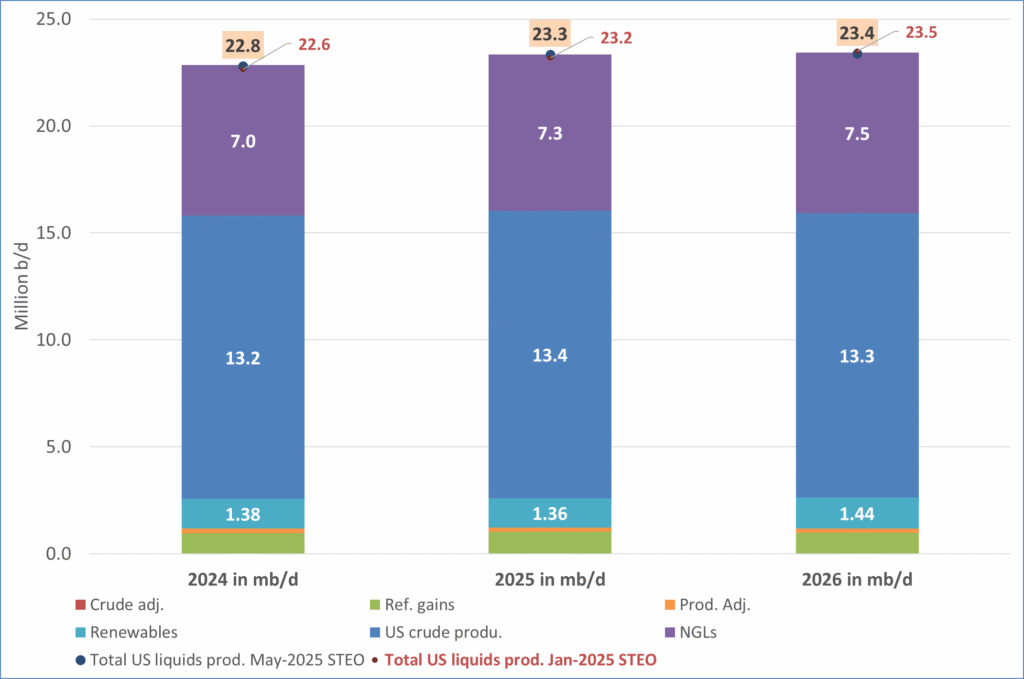
US IEA STEO September report. US crude oil production contracting in 2026, but NGLs still growing. Close to zero net liquids growth in total.
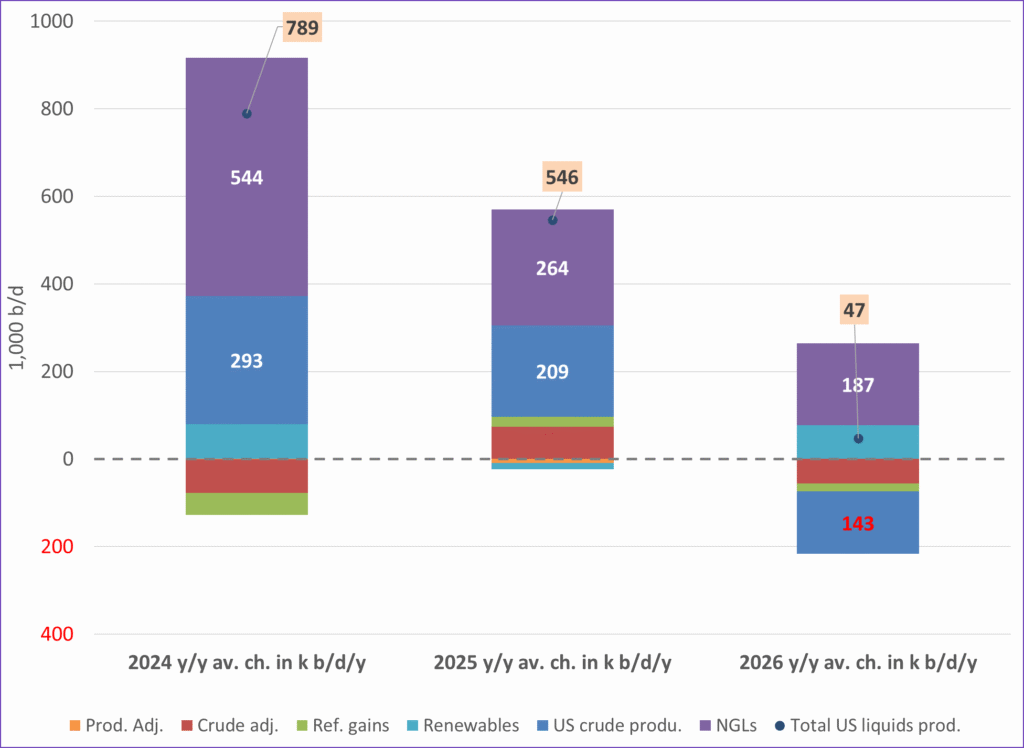
-

 Nyheter4 veckor sedan
Nyheter4 veckor sedanMeta bygger ett AI-datacenter på 5 GW och 2,25 GW gaskraftverk
-
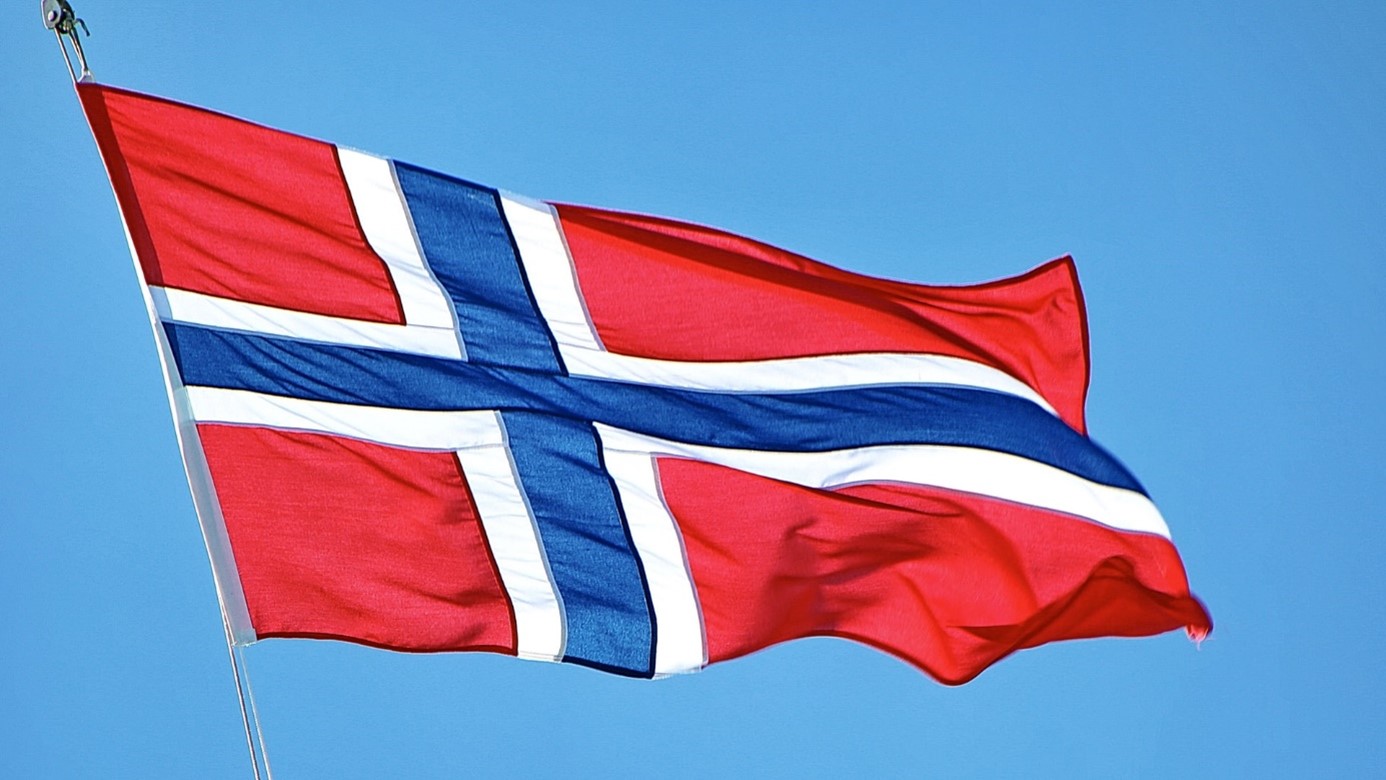
 Nyheter4 veckor sedan
Nyheter4 veckor sedanAker BP gör ett av Norges största oljefynd på ett decennium, stärker resurserna i Yggdrasilområdet
-

 Nyheter4 veckor sedan
Nyheter4 veckor sedanEtt samtal om koppar, kaffe och spannmål
-

 Analys4 veckor sedan
Analys4 veckor sedanBrent sideways on sanctions and peace talks
-

 Nyheter4 veckor sedan
Nyheter4 veckor sedanSommarens torka kan ge högre elpriser i höst
-

 Analys4 veckor sedan
Analys4 veckor sedanBrent edges higher as India–Russia oil trade draws U.S. ire and Powell takes the stage at Jackson Hole
-
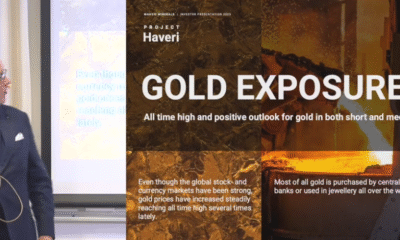
 Nyheter3 veckor sedan
Nyheter3 veckor sedanMahvie Minerals är verksamt i guldrikt område i Finland
-

 Analys3 veckor sedan
Analys3 veckor sedanIncreasing risk that OPEC+ will unwind the last 1.65 mb/d of cuts when they meet on 7 September


